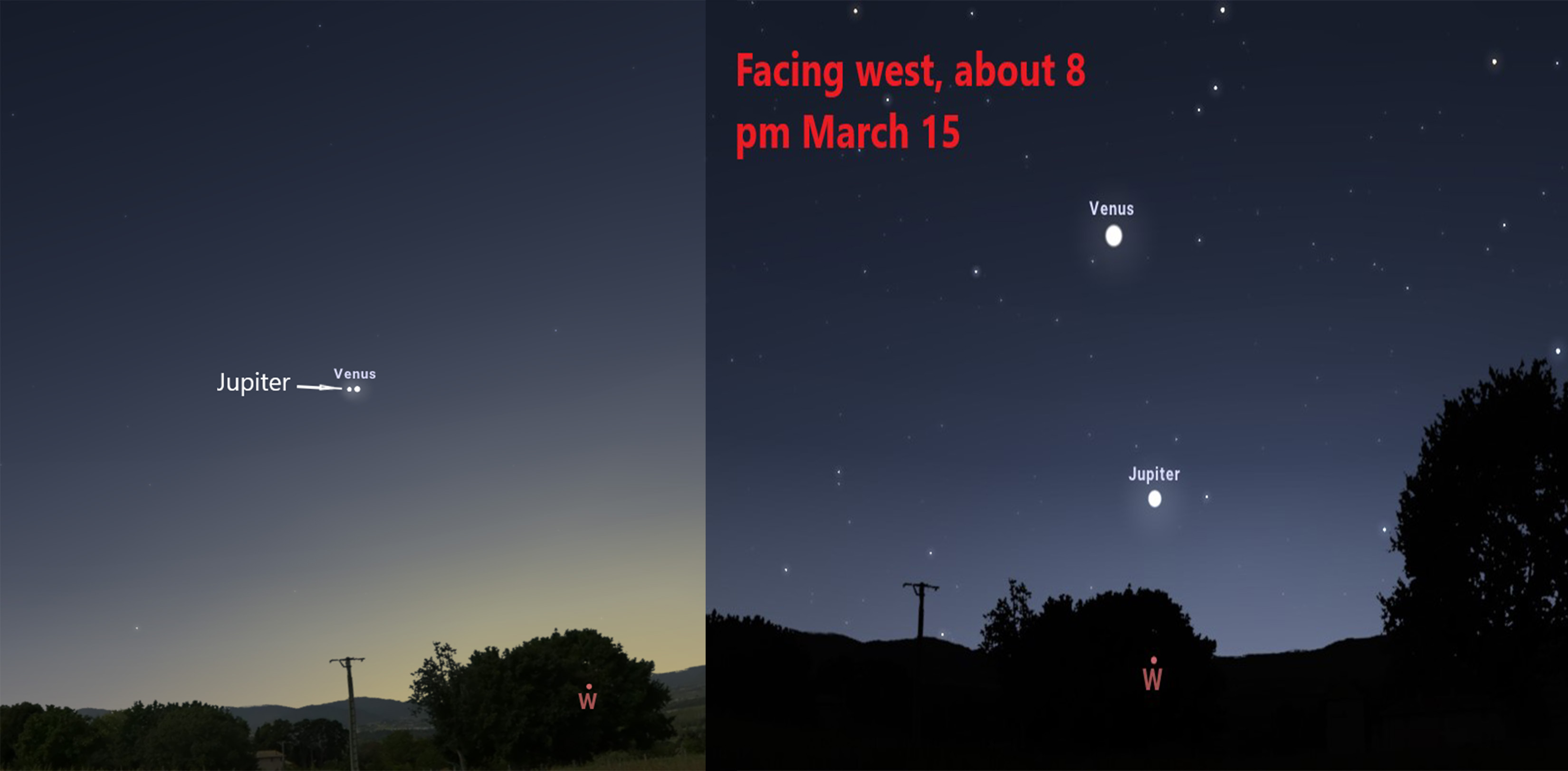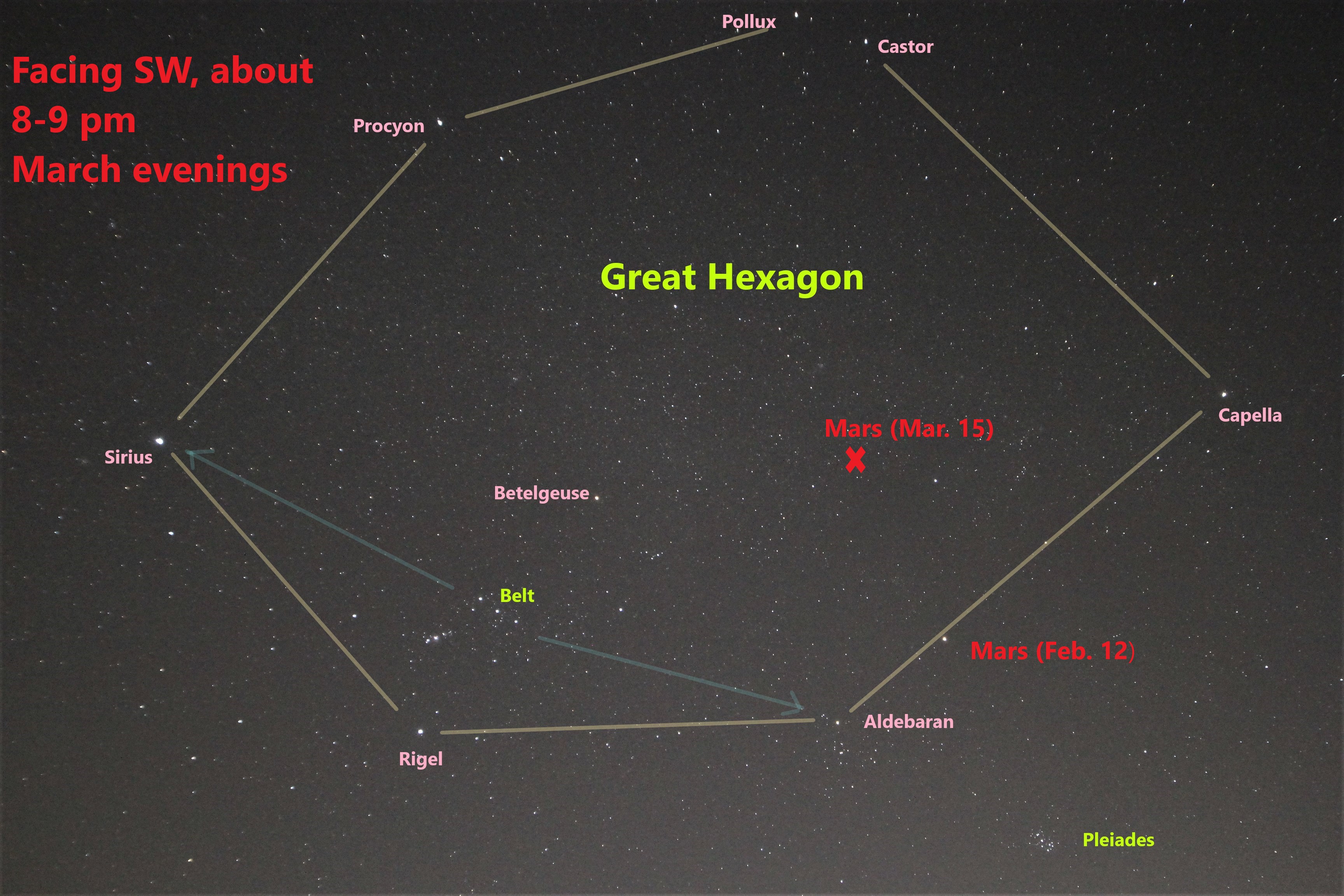GROUPINGS OF THE PLANETARY AND STELLAR KIND
I am sure that many of you who have wandered outside lately just after sunset lately have noticed the two bright “stars” in the west. They are none other than the planets Venus and Jupiter. Since Venus is comparatively close to us and the Sun, it shines much brighter than still-brilliant Jupiter. Roughly speaking, Venus passes Jupiter in the sky about once every 39 months, but this year’s event seems to be among the most beautiful, as they have been drawing closer and closer together, shining in the west after sunset as the twilight glow fades. The two appear closest, side by side, on the night of March 1st, about a full moon’s width apart- try snapping a picture with your cell phone, perhaps with some scenery in the background, as shown below. Jupiter’s slow twelve year orbit causes it to appear more and more on the far side of the Sun as seen from Earth, dropping ever farther to Venus’ lower right as March continues, into the twilight glow and out of sight before the end of the month. Much faster Venus will gain ground, appearing slightly higher and remaining visible longer for each night, as it puts on a fine appearance this spring, continuing into early summer.

Our Sky Ranger found an interesting spot behind the railroad tracks to capture this shot of Venus and Jupiter above the Gateway Arch at dusk on the night of February 27, using only a cell phone.

Venus and Jupiter, on the nights of March 1 (left) and March 15 (right). Face west, about an hour after sunset. Images courtesy of Stellarium.
As I have written previously in this blog, the skies of late winter and early spring are some of my favorite times to go stargazing. At no other time of year can so many brilliant stars be seen at a convenient hour of the evening, with temperatures usually a lot more comfortable than they were a couple of months ago. That is good, because as I get older, it gets harder to stay outside for long periods as various muscles and bones start to hurt and stiffen. It seems that the stars of this season often twinkle more than usual, as the changing season causes their light to shine through various masses of air in our atmosphere, adding still more to the beauty of the scene.
It is perfectly fine to just look at these stars, but to me it is even more enjoyable if you can identify the brighter stars. At first look, they might just look like tiny, twinkly dots, but a closer inspection can reveal a lot more, even if you live near the city. Even among the bright stars identified in my picture below, you can notice striking differences due to their distance from Earth as well as their varying temperatures and natural size. This is almost like an “icebreaker activity” like so many of us have experienced at meetings and events. From there, it is possible to get to know your favorite stars even better, learning about the science or ancient mythology behind them.

The Great Hexagon dominates the sky in this wide field image, taken by our Sky Ranger on the night of February 12.
Most of the bright stars of this season can be grouped into the giant shape of the Great (or Winter) Hexagon. I prefer the term “great” since these stars can be seen at other seasons if you stay up late or get up early in the morning. To trace out the Great Hexagon, start with Sirius, brilliantly bluish and white, in the south in the early evening. You can notice how the three stars of Orion’s belt point to Sirius, confirming the identification. Above and right of Sirius is Procyon, the lesser Dog Star, and then you can continue on high overhead to Pollux and Castor, the famous Gemini Twins of mythology.
A parallelogram of bright stars surrounds Orion’s belt, with the lower right star, Rigel forming another part of the Great Hexagon. A line through the belt, in the opposite direction from Sirius, points to Aldebaran, eye of Taurus, the Bull. And finally, bright Capella shines high in the west to northwest to complete the vast pattern.
Two bright, somewhat similar appearing “stars” shine inside the Great Hexagon. Giant Betelgeuse forms the corner of the Orion parallelogram opposite Rigel. While Betelgeuse is always in that spot, this year, the reddish orange planet Mars is also making its way through the area in its orbit. Although much diminished in brightness from its early winter peak, Mars still is a good match for the Great Hexagon stars. Both shine orange, but for very different reasons- the planet due to its iron oxide surface, the star due to its temperature.
Our 2023 Gateway to the Stars program will be held on the fourth Friday night of month, from May though October. An astronomy or National Park related talk will precede free telescope viewing on our West Entrance Plaza, provided by the Park and volunteers from the St. Louis Astronomical Society.
